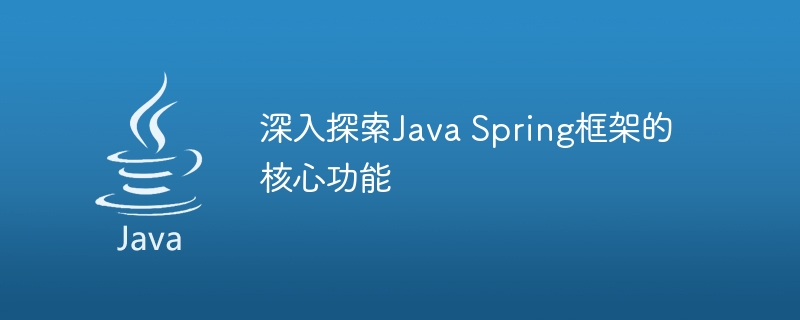Home >Java >javaTutorial >A deep dive into the key features of the Java Spring framework
A deep dive into the key features of the Java Spring framework
- WBOYWBOYWBOYWBOYWBOYWBOYWBOYWBOYWBOYWBOYWBOYWBOYWBOriginal
- 2023-12-30 09:01:111150browse

Java Spring framework is a popular application development framework that is widely used for building enterprise-level Java applications. It provides many core functions and features that enable developers to build scalable, flexible and maintainable applications in an efficient manner. This article will explore in depth the core features of the Java Spring framework.
- Inversion of Control (IoC) and Dependency Injection (DI)
One of the core concepts of the Java Spring framework is Inversion of Control (IoC) and Dependency Injection (DI). IoC achieves decoupling by handing over object creation, configuration, and management to containers. DI allows dependencies between objects to be dynamically injected in the container, thereby achieving loose coupling and testability. The Java Spring framework implements IoC and DI using bean containers, annotations, and XML configuration files. - Aspect Programming (AOP)
Aspect programming is another core function of the Java Spring framework. It allows developers to decouple business logic from system-level concerns. Aspects provide a way to separate cross-cutting concerns (such as logging, transaction management, etc.) from the core business logic. The Java Spring framework implements aspect programming through the use of AOP proxies, pointcuts, and advice. - Web Development
The Java Spring framework provides comprehensive support for Web development. It includes an MVC framework for handling HTTP requests and responses, and supports RESTful style web service development. The Java Spring framework also provides powerful form processing, validation and file upload functions. Developers can use annotations or XML configuration files to define controllers, request mappings, view resolvers, etc. - Data Access
The Java Spring framework provides a variety of data access methods. It supports the use of persistence frameworks such as JDBC, Hibernate, JPA and MyBatis. Developers can use annotations or XML configuration files to define data sources, transaction management, and ORM mapping. The Java Spring framework also provides convenient transaction management functions to ensure the consistency and reliability of data operations. - Security
The Java Spring framework provides powerful security features to protect applications from malicious attacks. It supports functions such as role-based access control (RBAC), encrypted communication, authentication and authorization. The Java Spring framework also provides security annotations and XML configuration files, allowing developers to define fine-grained access control policies. - Testing Support
The Java Spring framework provides comprehensive testing support. It includes various testing methods such as unit testing, integration testing and end-to-end testing. Developers can use tools such as JUnit, Mockito, and Spring Test for testing. The Java Spring framework also provides the function of in-memory database and simulated HTTP requests, making testing simpler and more efficient.
Summary:
The Java Spring framework is a powerful, flexible and scalable framework that is widely used in the development of enterprise-level Java applications. It provides many core functions and features, such as inversion of control and dependency injection, aspect programming, web development, data access, security and testing support, etc. By mastering these core capabilities, developers can efficiently build reliable and maintainable applications. Whether you are a beginner or an experienced developer, exploring the core features of the Java Spring framework is a recommended learning path.
The above is the detailed content of A deep dive into the key features of the Java Spring framework. For more information, please follow other related articles on the PHP Chinese website!

